Liquid Flow Meter by Fiber-Optic Sensing of Heat Propagation
Abstract
1. Introduction
2. Materials and Methods
2.1. Experimental Setup
2.2. Visualizing Heat Propagation
2.3. Peak Detection vs. “Center of Heat” Detection
3. Results
3.1. Recordings of Heat Propagation for Water and Ethanol
3.2. Estimating Measured Flow Rates
4. Discussion
5. Conclusions
Author Contributions
Funding
Institutional Review Board Statement
Informed Consent Statement
Data Availability Statement
Conflicts of Interest
References
- Jones, F.E. Techniques and Topics in Flow Measurement; CRC: Boca Raton, FL, USA, 1995. [Google Scholar]
- Cheremisinoff, N.P. Flow Measurement for Engineers and Scientists; Marcel Dekker: New York, NY, USA, 1988. [Google Scholar]
- Collins, J.; Lee, A.P. Flow Rate Measurements, Methods. In Encyclopedia of Microfluidics and Nanofluidics; Springer: Boston, MA, USA, 2013. [Google Scholar]
- Rasmussen, A.; Zaghloul, M.E. In the flow with MEMS. IEEE Circuits Devices Mag. 1998, 14, 12–25. [Google Scholar] [CrossRef]
- Kuo, J.T.W.; Yu, L.; Meng, E. Micromachined Thermal Flow Sensors—A Review. Micromachines 2012, 3, 550–573. [Google Scholar] [CrossRef]
- Oda, S.; Anzai, M.; Uematsu, S.; Watanabe, K. A silicon micromachined flow sensor using thermopiles for heat transfer measurements. IEEE Trans. Instrum. Meas. 2003, 52, 1155–1159. [Google Scholar] [CrossRef]
- Frazão, O.; Caldas, P.; Araújo, F.M.; Ferreira, L.A.; Santos, J.L. Optical flowmeter using a modal interferometer based on a single nonadiabatic fiber taper. Opt. Lett. 2007, 32, 1974–1976. [Google Scholar] [CrossRef] [PubMed]
- Byrne, G.D.; James, S.W.; Tatam, R.P. A Bragg grating based fibre optic reference beam laser Doppler anemometer. Meas. Sci. Technol. 2001, 12, 909–913. [Google Scholar]
- Huang, C.Y.; Chan, P.W.; Chang, H.Y.; Liu, W.F. A Fiber Bragg Grating-Based Anemometer. Sensors 2018, 18, 2213. [Google Scholar] [CrossRef] [PubMed]
- Dong, X.; Zhou, Y.; Zhou, W.; Cheng, J.; Su, Z. Compact Anemometer Using Silver-Coated Fiber Bragg Grating. IEEE Photonics J. 2012, 4, 1381–1386. [Google Scholar] [CrossRef]
- Hartog, A.H. An Introduction to Distributed Optical Fibre Sensors; CRC Press: Boca Raton, FL, USA, 2017. [Google Scholar]
- Lu, P.; Lalam, N.; Badar, M.; Liu, B.; Chorpening, B.T.; Buric, M.P.; Ohodnicki, P.R. Distributed optical fiber sensing: Review and perspective. Appl. Phys. Rev. 2019, 6, 041302. [Google Scholar] [CrossRef]
- Schenato, L. A Review of Distributed Fibre Optic Sensors for Geo-Hydrological Applications. Appl. Sci. 2017, 7, 896. [Google Scholar] [CrossRef]
- Selker, F.; Selker, J.S. Investigating Water Movement Within and NearWells Using Active Point Heating and Fiber Optic Distributed Temperature Sensing. Sensors 2018, 18, 1023. [Google Scholar] [CrossRef] [PubMed]
- Jderu, A.; Enachescu, M.; Ziegler, D. Mass Flow Monitoring by Distributed Fiber Optical Temperature Sensing. Sensors 2019, 19, 4151. [Google Scholar] [CrossRef] [PubMed]
- Kreger, S.T.; Rahim, N.A.A.; Garg, N.; Klute, S.M.; Metrey, D.R.; Beaty, N.; Jeans, J.W.; Gamber, R. Optical frequency domain reflectometry: Principles and applications in fiber optic sensing. In Proceedings of the SPIE 9852, Fiber Optic Sensors and Applications XIII, 98520T, Baltimore, MD, USA, 12–14 January 2016. [Google Scholar]
- White, F. Fluid Mechanics (Mcgraw-Hill Series in Mechanical Engineering), 7th ed.; Mcgraw-Hill Science/Engineering/Math: New York, NY, USA, 2010; p. 896. [Google Scholar]
- Goldstein, R.J. Fluid Mechanics Measurements, 2nd ed.; Taylor & Francis: Washington, DC, USA, 1996. [Google Scholar]
- Blumm, J.; Lindemann, A. Characterization of the thermophysical properties of molten polymers and liquids using the flash technique. High Temp-High Press. 2003, 35, 627–632. [Google Scholar] [CrossRef]

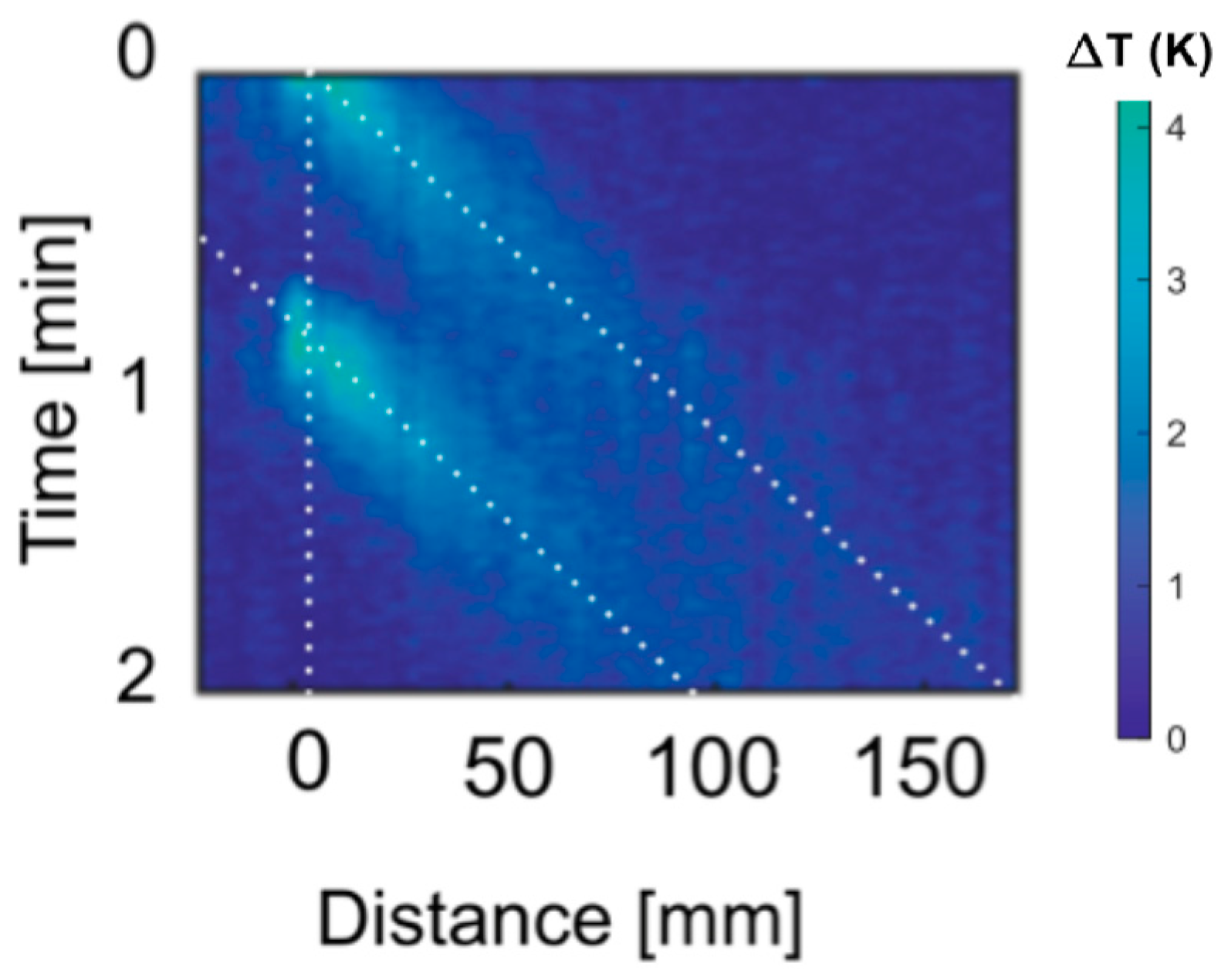
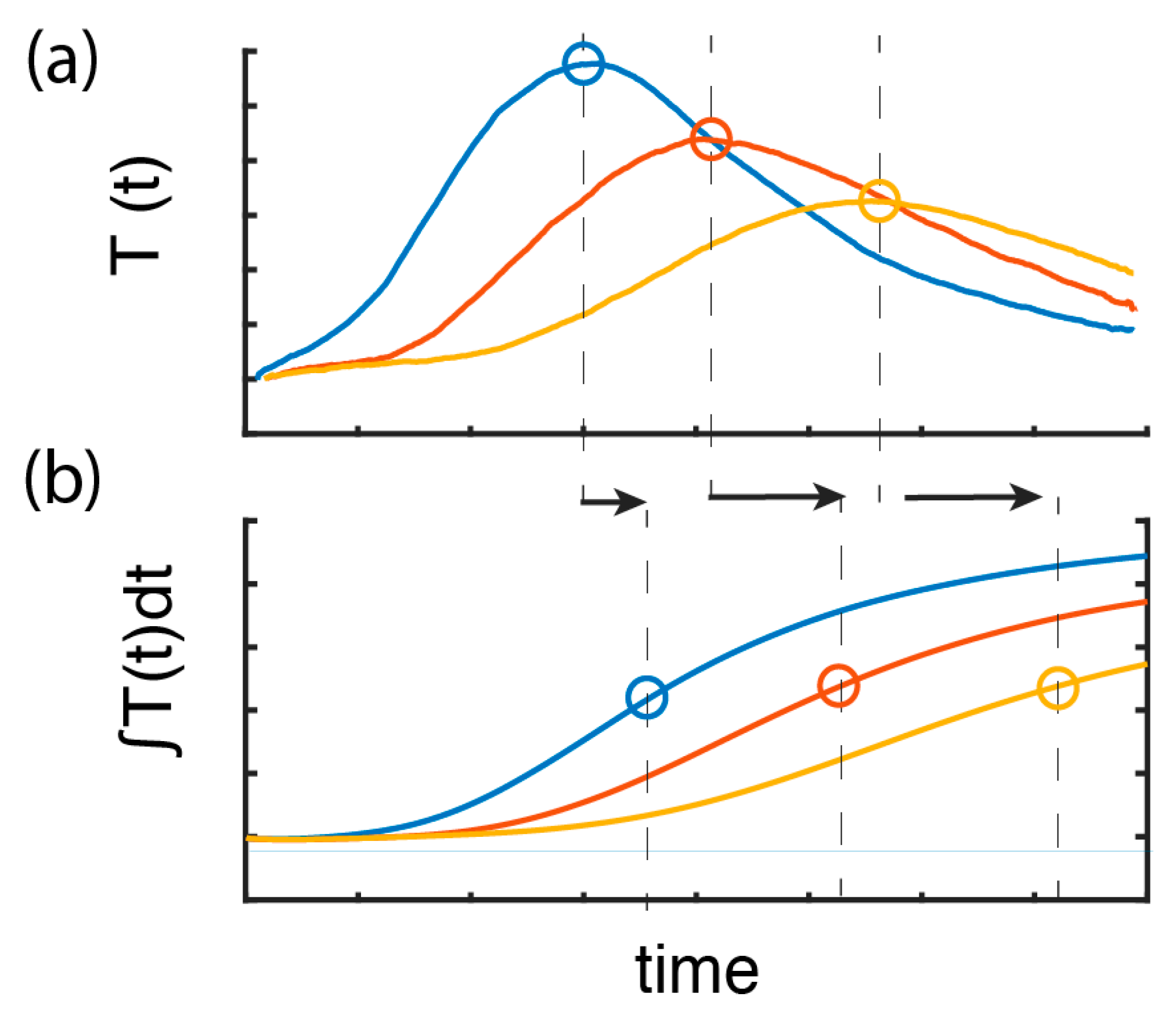
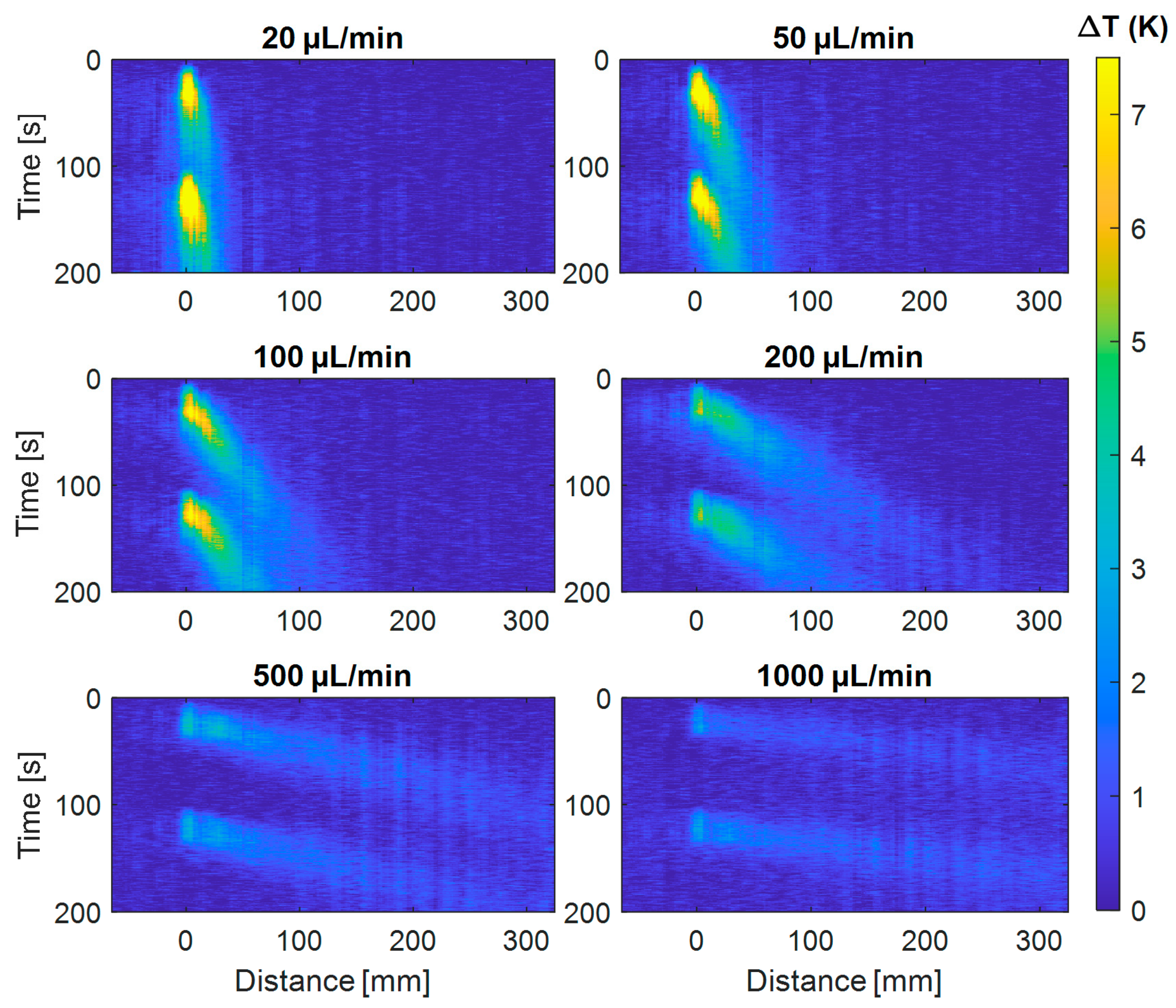
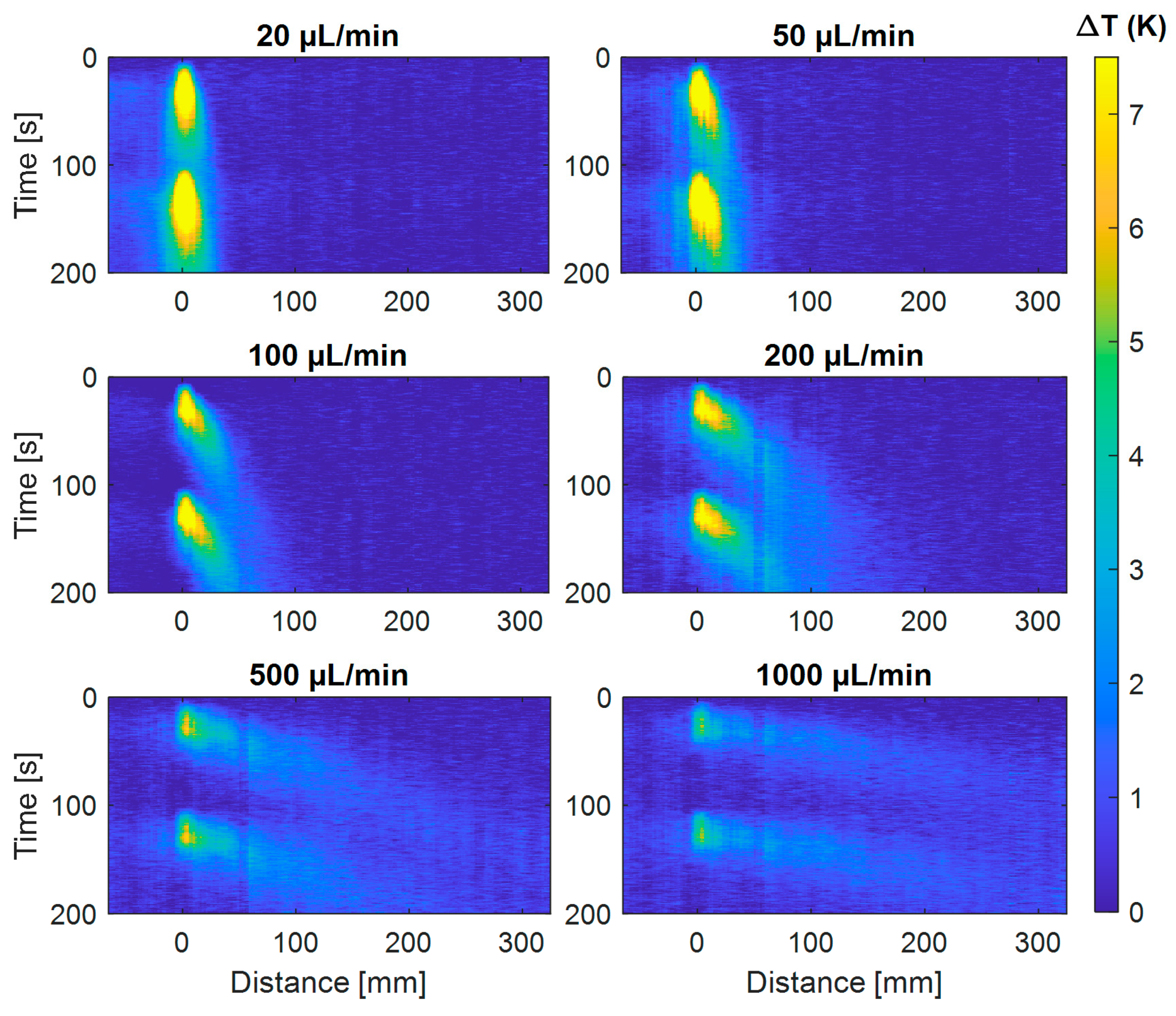
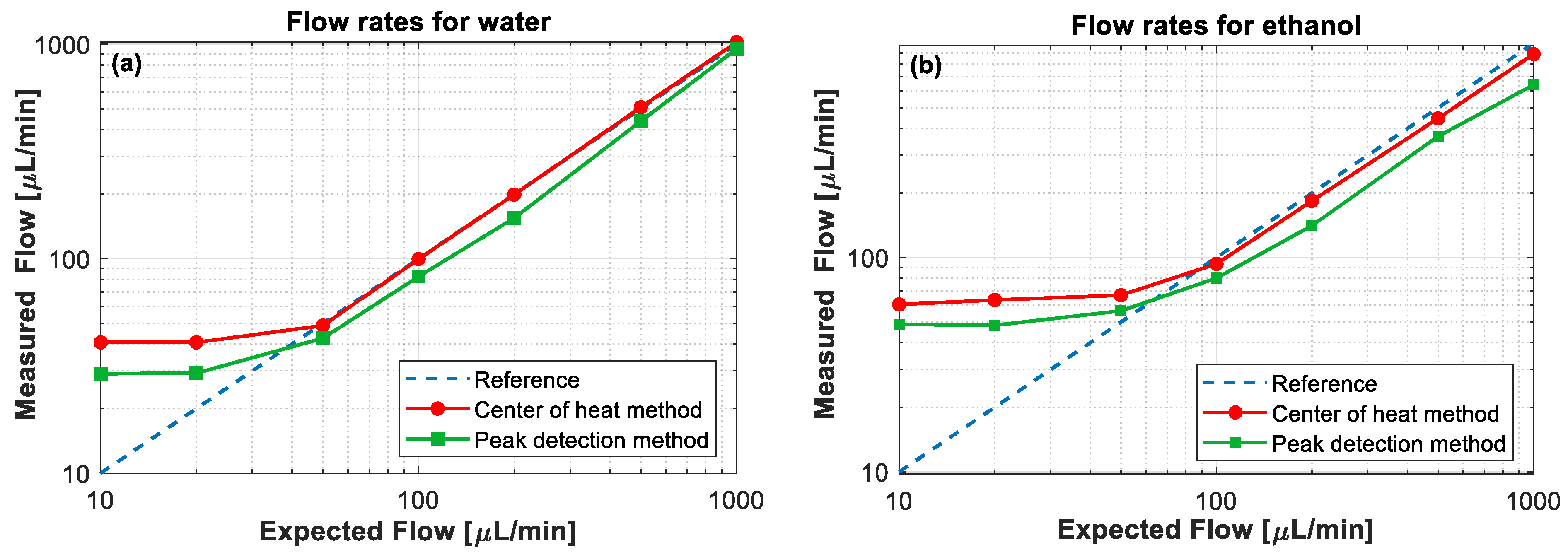
Publisher’s Note: MDPI stays neutral with regard to jurisdictional claims in published maps and institutional affiliations. |
© 2021 by the authors. Licensee MDPI, Basel, Switzerland. This article is an open access article distributed under the terms and conditions of the Creative Commons Attribution (CC BY) license (http://creativecommons.org/licenses/by/4.0/).
Share and Cite
Jderu, A.; Soto, M.A.; Enachescu, M.; Ziegler, D. Liquid Flow Meter by Fiber-Optic Sensing of Heat Propagation. Sensors 2021, 21, 355. https://doi.org/10.3390/s21020355
Jderu A, Soto MA, Enachescu M, Ziegler D. Liquid Flow Meter by Fiber-Optic Sensing of Heat Propagation. Sensors. 2021; 21(2):355. https://doi.org/10.3390/s21020355
Chicago/Turabian StyleJderu, Alin, Marcelo A. Soto, Marius Enachescu, and Dominik Ziegler. 2021. "Liquid Flow Meter by Fiber-Optic Sensing of Heat Propagation" Sensors 21, no. 2: 355. https://doi.org/10.3390/s21020355
APA StyleJderu, A., Soto, M. A., Enachescu, M., & Ziegler, D. (2021). Liquid Flow Meter by Fiber-Optic Sensing of Heat Propagation. Sensors, 21(2), 355. https://doi.org/10.3390/s21020355




